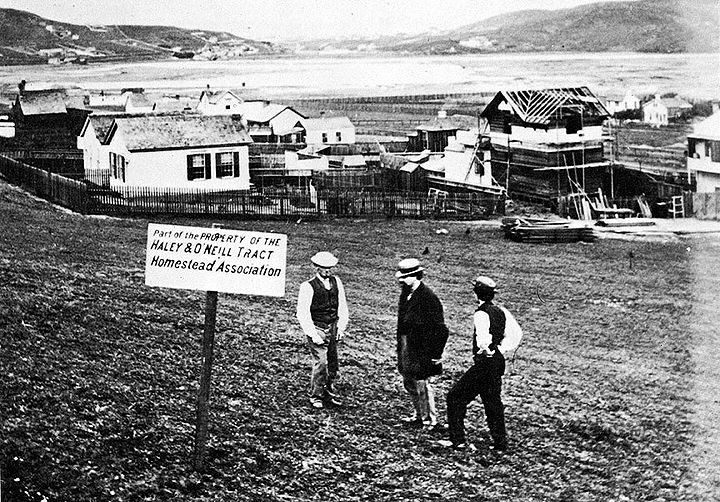Haley & O'Neill Tract: Difference between revisions
(Created page with ''''<font face = arial light> <font color = maroon> <font size = 3>Unfinished History</font></font> </font>''' 720px|thumb '''Taken...') |
No edit summary |
||
| (One intermediate revision by the same user not shown) | |||
| Line 3: | Line 3: | ||
[[Image:Haley-and-ONeill-Homestead-Assn.jpg|720px|thumb]] | [[Image:Haley-and-ONeill-Homestead-Assn.jpg|720px|thumb]] | ||
'''Taken from the slopes of today's "Silver Terrace" looking northwest across the wetlands of Islais Creek with Bernal Heights at left and Potrero Hill at right, the Mission District through the gap in the middle, where Precita Creek drained into the same wetlands.''' | '''Taken from the slopes of today's "Silver Terrace" looking northwest across the [[Islais Creek wetlands|wetlands of Islais Creek]] with Bernal Heights at left and Potrero Hill at right, the Mission District through the gap in the middle, where Precita Creek drained into the same wetlands.''' | ||
''Photo: Bancroft Library'' | ''Photo: Bancroft Library'' | ||
The Haley & O'Neill Homestead Association was one of many such endeavors in the 1860s and 1870s that helped subdivide and sell off San Francisco real estate. An 1867 ''Alta | The Haley & O'Neill Homestead Association was one of many such endeavors in the 1860s and 1870s that helped subdivide and sell off San Francisco real estate. An 1867 ''Alta California'' ad for the Haley and O’Neill Tract, bounded by today’s Evans Avenue, Bayshore Boulevard, Third Street and Revere Avenue, stated that “the lands cover the most beautiful locality in the city of San Francisco, famous for productiveness of soil and freedom from the prevailing winds and fogs of the city, as well as for picturesque and beautiful views.” | ||
California'' ad for the Haley and O’Neill Tract, bounded by today’s Evans Avenue, Bayshore Boulevard, Third Street and Revere Avenue, stated that “the lands cover the most beautiful locality in the city of San Francisco, famous for productiveness of soil and freedom from the prevailing winds and fogs of the city, as well as for picturesque and beautiful views.” | |||
Echoing the claims of twenty years prior, the owners felt that the new lands were an ideal place for settlement. They waited for the multitudes to arrive. In a repeat of history, few came. This was still an area that most people considered too far away from the commercial center of San Francisco. | Echoing the claims of twenty years prior, the owners felt that the new lands were an ideal place for settlement. They waited for the multitudes to arrive. In a repeat of history, few came. This was still an area that most people considered too far away from the commercial center of San Francisco. | ||
[[category:1870s]] [[category:Bayview | [[category:1870s]] [[category:Bayview/Hunter's Point]] [[category:real estate]] | ||
Latest revision as of 08:17, 18 May 2013
Unfinished History
Taken from the slopes of today's "Silver Terrace" looking northwest across the wetlands of Islais Creek with Bernal Heights at left and Potrero Hill at right, the Mission District through the gap in the middle, where Precita Creek drained into the same wetlands.
Photo: Bancroft Library
The Haley & O'Neill Homestead Association was one of many such endeavors in the 1860s and 1870s that helped subdivide and sell off San Francisco real estate. An 1867 Alta California ad for the Haley and O’Neill Tract, bounded by today’s Evans Avenue, Bayshore Boulevard, Third Street and Revere Avenue, stated that “the lands cover the most beautiful locality in the city of San Francisco, famous for productiveness of soil and freedom from the prevailing winds and fogs of the city, as well as for picturesque and beautiful views.”
Echoing the claims of twenty years prior, the owners felt that the new lands were an ideal place for settlement. They waited for the multitudes to arrive. In a repeat of history, few came. This was still an area that most people considered too far away from the commercial center of San Francisco.

